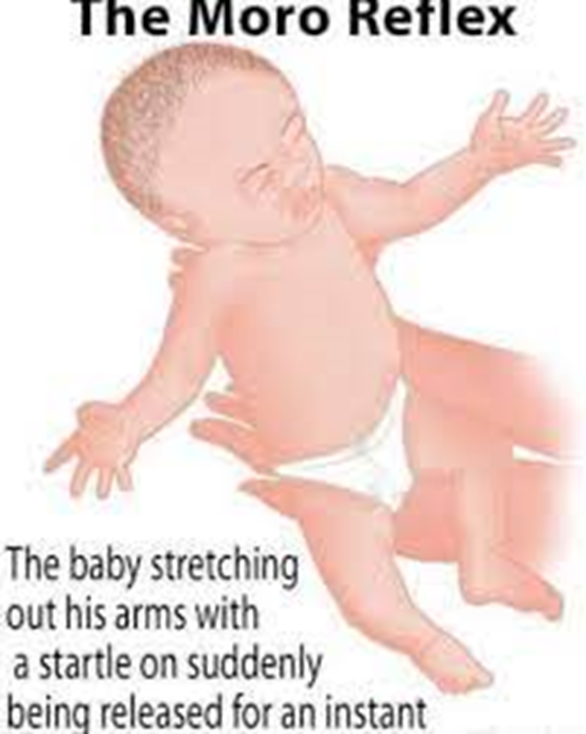A nurse is caring for a newborn and assessing newborn reflexes. To elicit the Moro reflex, the nurse should take which of the following actions?
Place a finger at the base of the newborn’s toes.
Turn the newborn’s head quickly to one side.
Hold the newborn vertically allowing one foot to touch the table surface.
Perform a sharp hand clap near the infant.
The Correct Answer is D
Choice A reason:
Placing a finger at the base of the newborn’s toes is used to elicit the Babinski reflex, not the Moro reflex. The Babinski reflex is observed when the toes fan out and the big toe moves upward in response to stroking the sole of the foot1. This reflex is a normal finding in infants up to 2 years old and indicates normal neurological development.
Choice B reason:
Turning the newborn’s head quickly to one side is used to elicit the tonic neck reflex, also known as the “fencing” reflex. When the head is turned to one side, the arm on that side extends while the opposite arm bends at the elbow, resembling a fencing position2. This reflex is typically present from birth to about 6 months of age.
Choice C reason:
Holding the newborn vertically and allowing one foot to touch the table surface is used to elicit the stepping reflex. When the baby’s foot touches a surface, they will make stepping movements as if trying to walk3. This reflex is usually present from birth until about 2 months of age.
Choice D reason:
Performing a sharp hand clap near the infant is a method to elicit the Moro reflex, also known as the startle reflex. The Moro reflex is triggered by a sudden loud noise or a sensation of falling. The infant will respond by extending and abducting the arms, opening the hands, and then bringing the arms back to the body. This reflex is present at birth and typically disappears by 4 to 6 months of age.

Nursing Test Bank
Naxlex Comprehensive Predictor Exams
Related Questions
Correct Answer is A
Explanation
Choice A reason:
Observing for meconium in respiratory secretions is crucial for newborns who are small for gestational age (SGA). Meconium aspiration syndrome (MAS) is a significant risk for these infants. Meconium, the first stool of an infant, can be passed into the amniotic fluid before or during labor, especially in cases of fetal distress. If the newborn inhales this meconium-stained fluid, it can lead to severe respiratory issues, including airway obstruction, inflammation, and infection. Therefore, careful monitoring and immediate intervention are necessary to prevent complications associated with MAS.
Choice B reason:
Monitoring for hyperthermia is not typically a primary concern for SGA infants. These infants are more prone to hypothermia due to their lower body fat and reduced ability to regulate body temperature. While maintaining a stable temperature is essential, the risk of hyperthermia is less common compared to hypothermia. Therefore, this intervention is not as critical as others for SGA infants.
Choice C reason:
Identifying manifestations of anemia is important but not the most immediate concern for SGA infants. Anemia can occur in these infants due to various factors, including intrauterine growth restriction and maternal conditions. However, the immediate postnatal period requires more urgent interventions, such as monitoring for respiratory distress and hypoglycemia. Anemia can be assessed and managed as part of the ongoing care plan.
Choice D reason:
Monitoring for hyperglycemia is not a primary concern for SGA infants. In fact, these infants are at a higher risk of hypoglycemia due to their limited glycogen stores and increased metabolic demands. Hypoglycemia can lead to serious complications, including neurological damage if not promptly addressed. Therefore, monitoring blood glucose levels and ensuring adequate nutrition are critical interventions for SGA infants.
Correct Answer is ["A","C","D"]
Explanation
Choice A reason:
Vernix in the folds and creases: Vernix caseosa is a white, cheese-like substance that covers the skin of the fetus. In post-term newborns, vernix is typically absent or only present in small amounts in the folds and creases of the skin.
Choice B reason:
Abundant lanugo: Lanugo is fine, soft hair that covers the body of the fetus. It is usually shed before birth, and post-term infants typically have little to no lanugo.
Choice C reason:
Positive Moro reflex: The Moro reflex, or startle reflex, is a normal reflex for an infant when they feel as if they are falling. This reflex is present at birth and usually disappears by 4 months of age.
Choice D reason:
Cracked peeling skin: Post-term infants often have dry, cracked, and peeling skin due to prolonged exposure to amniotic fluid.
Choice E reason:
Short soft fingernails: Post-term infants usually have long fingernails, not short and soft ones.
Whether you are a student looking to ace your exams or a practicing nurse seeking to enhance your expertise , our nursing education contents will empower you with the confidence and competence to make a difference in the lives of patients and become a respected leader in the healthcare field.
Visit Naxlex, invest in your future and unlock endless possibilities with our unparalleled nursing education contents today
Report Wrong Answer on the Current Question
Do you disagree with the answer? If yes, what is your expected answer? Explain.
Kindly be descriptive with the issue you are facing.
